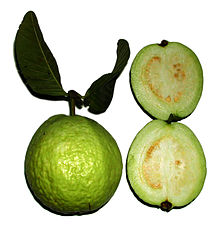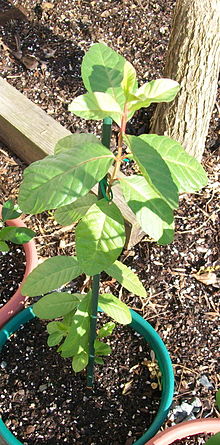- Psidium guajava
-
Apple Guava 
Apple Guava (Psidium guajava) fruit Scientific classification Kingdom: Plantae (unranked): Angiosperms (unranked): Eudicots (unranked): Rosids Order: Myrtales Family: Myrtaceae Subfamily: Myrtoideae Tribe: Myrteae Genus: Psidium Species: P. guajava Binomial name Psidium guajava
L.The apple guava or common guava (Psidium guajava; known as Goiaba in Brazil and Guayava in parts of The Americas) is an evergreen shrub or small tree native to Mexico, the Caribbean, and Central and South America.[1] It is easily pollinated by insects; in culture, mainly by the common honey bee, Apis mellifera.
Widely cultivated in tropical and subtropical regions around the world, guava fruits can range in size from as small as an apricot to as large as a grapefruit. Various cultivars have white, pink, or red flesh, and a few also feature red (instead of green) skin.
When cultivated from seed, guavas are notable for an extremely slow growth rate for several months, before a very rapid acceleration in growth rate takes over. From seed, common guavas may bloom and set fruit in as few as 2 years, or as many as 8. Cuttings and grafting are more commonly used as a propagation method in commercial groves. Highly adaptable, guavas can be easily grown as container plants in temperate regions, though their ability to bloom and set fruit is somewhat less predictable. In some tropical locales, guavas can become invasive.
The plant is used in many different shampoo products for its scent. It is also becoming a popular Bonsai Species and is currently quite popular in India and Eastern Asia.[2]
References
- ^ "Psidium guajava". Germplasm Resources Information Network. United States Department of Agriculture. 1995-10-17. http://www.ars-grin.gov/cgi-bin/npgs/html/taxon.pl?30205. Retrieved 2009-02-06.
- ^ D'Cruz, Mark. "Ma-Ke Bonsai Care Guide for Psidium guajava". Ma-Ke Bonsai. http://makebonsai.com/guide/bonsailink.asp?quicklink=5108&name=Psidium_guajava. Retrieved 2011-4-22.
External links

This Myrtaceae article is a stub. You can help Wikipedia by expanding it.


